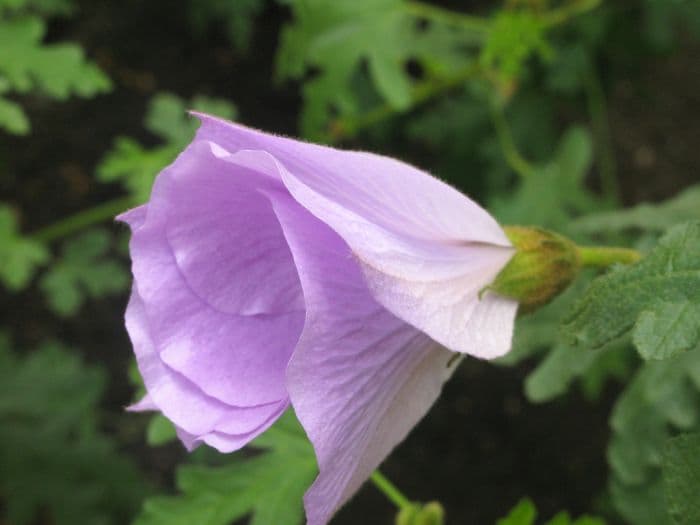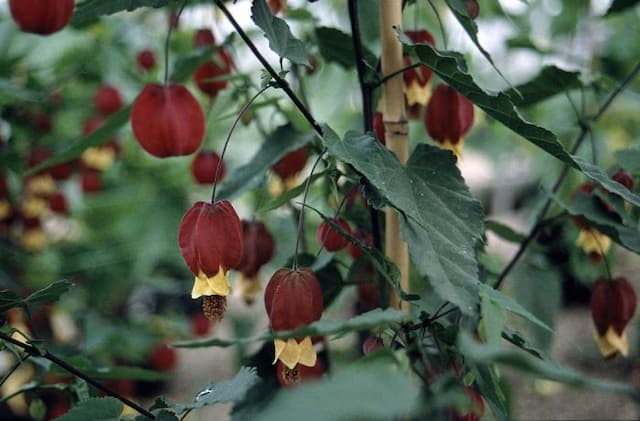Blue Hibiscus Alyogyne huegelii 'Santa Cruz'

ABOUT
Santa Cruz is a visually striking plant, adorned with large, showy blooms often likened to those of hibiscus, to which it is somewhat related. Its flowers are a deep lavender to violet hue, providing a vibrant pop of color in any garden where it resides. Each flower features five soft, overlapping petals that create an almost saucer-like shape, emerging from a center that houses delicate, protruding stamen which adds to its ornamental appeal. The foliage of Santa Cruz is equally attractive, composed of leaves that are bright green and lightly textured. The leaves possess a slightly glossy appearance and are divided into lobed or finger-like segments which emanate from the stems, giving the plant a delicate and intricate look. The overall bushy habit of Santa Cruz creates a lush and dense appearance, with branches that spread out and are liberally covered in these delightful green leaves. This particular plant is known for its long blooming season, often providing color and interest throughout the warmer months. As such, it has become a favorite among gardeners looking to add lasting vibrancy to their landscapes. The stems of Santa Cruz are sturdy enough to support the substantial flowers and the verdant foliage, ensuring that the plant maintains an appealing form as it matures. In summary, Santa Cruz is a striking specimen with bold, vibrant flowers and lovely lobed leaves which together create a showy display, sure to captivate anyone who has the pleasure of viewing it. Its tendency to bloom profusely throughout the season makes it a cherished addition to many gardens seeking a touch of drama and color.
About this plant
 Names
NamesFamily
Malvaceae
Synonyms
Blue Hibiscus, Lilac Hibiscus, Australian Hibiscus, Blue Hibiscus Rosemallow
Common names
Alyogyne huegelii 'Santa Cruz'.
 Toxicity
ToxicityTo humans
Blue Hibiscus (Alyogyne huegelii 'Santa Cruz') is not commonly known to be toxic to humans. There is no well-documented evidence of poisoning from this plant. However, as with any plant, individual allergies can occur, and it is generally not advisable to ingest parts of ornamental plants not intended for consumption.
To pets
Blue Hibiscus (Alyogyne huegelii 'Santa Cruz') is not widely recognized as being poisonous to pets. There is a lack of significant evidence to suggest that this plant causes toxicity in animals. As with humans, it's still prudent to prevent pets from consuming plants not meant for dietary purposes, as gastrointestinal upset or an allergic reaction can occur in sensitive individuals.
 Characteristics
CharacteristicsLife cycle
Perennials
Foliage type
Evergreen
Color of leaves
Green
Flower color
Purple
Height
5 feet (1.5 meters)
Spread
5 feet (1.5 meters)
Plant type
Shrub
Hardiness zones
9
Native area
Australia
Benefits
 General Benefits
General Benefits- Attracts Pollinators: Alyogyne huegelii 'Santa Cruz', commonly known as Blue Hibiscus, attracts bees, butterflies, and other beneficial pollinators to the garden.
- Drought Tolerance: Once established, Blue Hibiscus is known for its ability to tolerate periods of dryness, making it suitable for water-wise landscapes.
- Low Maintenance: This plant generally requires minimal care beyond occasional pruning, which is appreciated by gardeners looking for low-maintenance options.
- Fast Growth: Blue Hibiscus is a fast-growing plant, providing quick coverage or filling in garden spaces efficiently.
- Landscape Aesthetics: With its vibrant blue-purple flowers, it offers a striking visual appeal that can enhance the beauty of any garden.
- Adaptability: It can adapt to a variety of soil types as long as they are well-draining, giving it a broad range of potential planting locations.
- Privacy Screen: Its dense growth habit allows it to be used as a natural privacy screen or windbreak in landscaping.
- Long Flowering Season: Blue Hibiscus has a prolonged blooming period, providing long-lasting color and interest in the garden.
 Medical Properties
Medical PropertiesThis plant is not used for medical purposes.
 Air-purifying Qualities
Air-purifying QualitiesThis plant is not specifically known for air purifying qualities.
 Other Uses
Other Uses- Alyogyne huegelii, commonly known as Blue Hibiscus, can be used in cut flower arrangements due to its attractive blooms, adding a touch of vibrant color to floral displays.
- The dense, shrubby growth habit of Blue Hibiscus makes it suitable as a privacy screen or hedge in gardens and parks, offering seclusion and aesthetic appeal.
- The wood from the Blue Hibiscus can be carved into small decorative objects or utensils, taking advantage of its woody stems once the plant has matured and been pruned.
- Due to its long flowering season, Blue Hibiscus serves as an excellent resource for nectar-feeding insects and birds, supporting local biodiversity.
- The striking blooms of the Blue Hibiscus can be used as a natural dye source for fabrics, imparting subtle colors when processed correctly.
- The plant can be incorporated into educational programs and botanical displays to teach about native Australian flora and the importance of plant conservation.
- Blue Hibiscus can be used in themed gardens, such as Mediterranean or drought-resistant landscapes, due to its adaptability to various garden styles.
- As a subject for photography and botanical illustration, the Blue Hibiscus offers an excellent opportunity for artists to capture its unique beauty.
- In ceremonial events or local festivals, the blossoms of the Blue Hibiscus can be used for decorating venues or creating traditional garlands.
- The fallen petals of Blue Hibiscus can be scattered over pathways or mixed into potpourris for a colorful and subtle fragrant addition to indoor spaces.
Interesting Facts
 Feng Shui
Feng ShuiThe Blue Hibiscus is not used in Feng Shui practice.
 Zodiac Sign Compitability
Zodiac Sign CompitabilityThe Blue Hibiscus is not used in astrology practice.
 Plant Symbolism
Plant Symbolism- Resilience: The Alyogyne huegelii, commonly known as Lilac Hibiscus, can thrive in drought conditions, symbolizing the ability to endure and adapt to challenging situations.
- Rare Beauty: With its uncommon lilac-colored blooms, the Lilac Hibiscus represents uniqueness and the appreciation for rare beauty in life.
- Femininity: The delicate flowers of the Lilac Hibiscus are often associated with grace and femininity, reflecting the soft and gentle aspects of nature.
- Inviting Energy: The vibrant blossoms of the Lilac Hibiscus can symbolize an inviting and friendly disposition, emblematic of hospitality and warmth.
 Water
WaterThe Blue Hibiscus should be watered deeply but infrequently, allowing the topsoil to dry out between waterings to prevent root rot. During the growing season in spring and summer, water approximately once a week, using about 1 gallon of water for each plant. In the cooler months of fall and winter, reduce watering to once every two weeks or less, depending on the climate and weather conditions. Always check the soil moisture before watering to ensure it's necessary, as overwatering can be detrimental to the plant’s health.
 Light
LightThe Blue Hibiscus thrives in full sun conditions and should be placed in a spot where it receives at least 6 to 8 hours of direct sunlight daily. Partial shade is tolerated but may result in fewer flowers. For optimal blooming and growth, ensure the plant has ample light throughout the day, avoiding deep shade which can hinder its performance.
 Temperature
TemperatureBlue Hibiscus plants are best grown in warm conditions and can tolerate a temperature range from around 50 degrees Fahrenheit at night to 90 degrees Fahrenheit during the day. They can survive minimum temperatures down to about 40 degrees Fahrenheit, but frost can be damaging. Ideally, maintain an ambient temperature between 60 and 85 degrees Fahrenheit for the plant's well-being.
 Pruning
PruningPrune the Blue Hibiscus to maintain its shape and encourage bushier growth. Pruning should be done in late winter or early spring before new growth begins. Remove any dead or damaged wood, and cut back up to one-third of the plant to promote fresh growth. Pruning is also a good opportunity to remove any weak stems to ensure the plant's energy is directed towards thriving branches.
 Cleaning
CleaningAs needed
 Soil
SoilBlue Hibiscus thrives in well-draining sandy to loamy soil with a pH of 5.5 to 7.5. An ideal mix could be two parts sand, two parts garden soil, one part peat or compost to ensure adequate nutrients and drainage.
 Repotting
RepottingBlue Hibiscus typically needs repotting every 2 to 3 years, or when it outgrows its current container, whichever comes first.
 Humidity & Misting
Humidity & MistingBlue Hibiscus prefers moderate to low humidity levels, which align with typical household environments, avoiding excessively high humidity.
 Suitable locations
Suitable locationsIndoor
Place in bright, indirect light and avoid overwatering.
Outdoor
Grow in sunny spot, shelter from strong winds, well-drained soil.
Hardiness zone
9-11 USDA
 Life cycle
Life cycleAlyogyne huegelii 'Santa Cruz', commonly known as the Blue Hibiscus, begins its life cycle when its seeds germinate in favorable conditions, typically in well-draining soil and in a climate that doesn't experience extreme cold. After germination, the seedling stage occurs, characterized by the emergence of the first pair of true leaves, alongside the seed leaves (cotyledons). As the plant enters the vegetative stage, it establishes a root system and grows rapidly, producing multiple branches and lush, green foliage. Flowering occurs next, with the Blue Hibiscus producing its distinctive large, colorful blooms, commonplace throughout the warmer months if the plant is well-cared for. After pollination, the fertilized flowers produce seed pods that eventually dry and release seeds, completing the reproductive cycle. The life of the plant can continue for several years as a perennial, with periods of active growth and flowering followed by dormancy, particularly in climates with cooler winters.
 Propogation
PropogationPropogation time
Spring-Early Summer
Propogation: The most popular method of propagating the Blue Hibiscus, also known as Alyogyne huegelii 'Santa Cruz', is through cuttings. This is typically done in the warmer months of the year, such as late spring or early summer. Semi-hardwood cuttings, which are partially mature stems, are most successful. To propagate, a cutting about 4 to 6 inches (10 to 15 centimeters) in length should be taken just below a leaf node and then stripped of the lower leaves. The cut end is often treated with rooting hormone to encourage root development and then planted in a well-draining mix. The cutting should be kept moist and in indirect sunlight until roots have established, a process that can take several weeks. Once rooted, the cutting can be transferred to a larger pot or directly planted in the garden.









